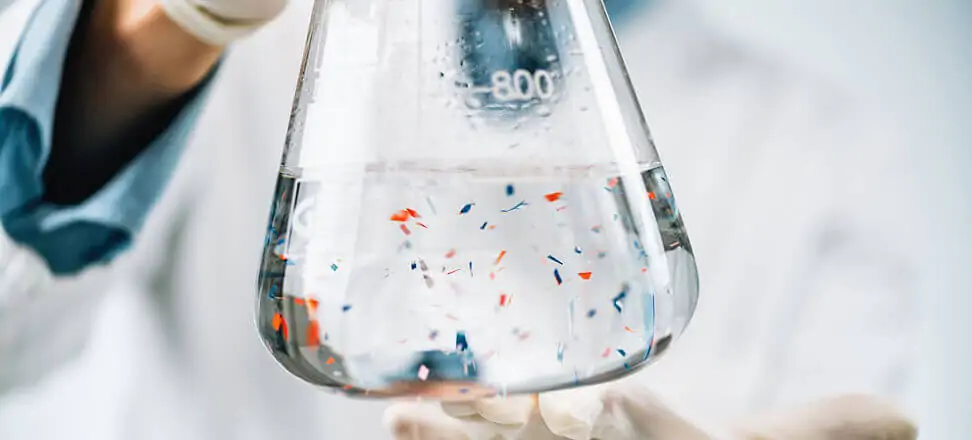Science
Is microplastic a threat to the efficiency of wastewater treatment technology?
Microplastics are small plastic particles, less than 5 mm in size, that have a significant impact on our environment [1]. Ubiquitous in the seas, oceans, coastal zones, inland waters and even in glaciers, they continue to surprise scientists with their ability to expand rapidly and have multi-level effects on organisms.
Where does microplastic come from in treatment plants?
In recent years, researchers have been looking more and more intensively at wastewater treatment plants, which are the main source of the release of these particles into the water and soil environment. Microplastic enters the treatment plant via both sanitary and storm sewers. Fiber is present in the wastewater, primarily from textiles, but also particles from cosmetics or city dust, which contains, among other things. Pollution from abrading tires. Studies show that the number of particles in 1 liter of wastewater can range from 1,000 to as many as 13,000.
The most common are polymers, such as polyester (PES) and polyethylene (PE) [1]. Although the efficiency of conventional wastewater treatment plants in retaining microplastic particles often exceeds 90%, environmental exposure does not significantly decrease [2]. Since analytical methods for detecting microplastics are still under development and refinement, we still do not know the real scale of the threat.
Increasingly, there is talk about the high harmfulness of the so-called “high risk”. nanoplastics, which are those smallest particles that can even cross the blood-brain barrier [1, 3]. Microplastics are primarily accumulated in sewage sludge (more than 90%), whose short processing time does not allow the particles to biodegrade [2].
Microorganisms in the service of wastewater treatment
Scientists have already isolated more than 400 microorganisms that are capable of accelerating the decomposition of plastics. Among them are bacteria that participate in wastewater treatment processes, using polymers as an additional carbon source [1]. However, the processes of microbial degradation of plastics often require the creation of strongly favorable conditions – appropriate temperature, UV radiation, microorganisms with an appropriate enzymatic array [4].
In addition, plastics often contain many chemical additives (plasticizers, heavy metals, polychlorinated biphenyls) that can inhibit the growth of microorganisms and even alter the structures of entire communities, disrupting biodegradation processes. The specific properties of plastic particles mean that once they enter any environment, they begin to sorb any contaminants present there.
They form specific hot-spots where, in addition to high concentrations of toxic chemicals and heavy metals, pathogenic microorganisms are found, often possessing and transmitting antibiotic resistance genes. Microplastics can harm organisms at all trophic levels, starting with microorganisms and ending with animals and humans [4, 5].
Bacteria play a key role in wastewater treatment plants. Biological nitrogen removal processes are carried out by ammonia-oxidizing bacteria (AOB), nitrite-oxidizing bacteria (NOB) and denitrifiers. AOBs first oxidize ammonia to nitrite, then NOBs oxidize nitrite to nitrate (this is a two-step nitrification process). A group of denitrifiers then reduces nitrates to gaseous nitrogen (denitrification process).
Biological phosphorus removal, on the other hand, is supplemented by polyphosphate-accumulating organisms (PAOs). PAOs take up volatile fatty acids under anaerobic conditions, which they use to form intracellular polymers [4].
Microplastics can negatively impact treatment plant processes
When microplastic particles enter a wastewater treatment plant, they can interact with bacteria that are actively involved in treatment and negatively impact the efficiency of the processes themselves. In 2019. The researchers studied the effect of particles of common polymers – polyethylene, polyester, polyvinyl chloride – on the activity of AOBs, NOBs and PAOs. Microplastics at concentrations of 50 to 10,000 particles/liter did not significantly affect the activity of bacteria involved in the metabolism of nitrogen and phosphorus compounds [4].
However, we must keep in mind that the authors used virgin microplastics for their study, which came directly from the manufacturer and were not in contact with a number of contaminants that are present in the aquatic environment and which determine the ultimate toxicity of the particles. In addition, the elements used in the study were in the size range of 100 – 2000 μm (micrometers), while microplastics detected in wastewater treatment plants are more diverse in size (in the range of 10 to 5000 μm).
Scientists in laboratory conditions dealt with fairly uniform forms and shapes of particles, while in real-world conditions microplastics in treatment plants are primarily fibers from textile washing, which can easily “escape” analysis. These problems have been recognized in other studies, which have shown that microplastics, especially nanoplastics, affect the efficiency of inorganic nitrogen conversion and can inhibit the denitrification process, leading to ammonia accumulation. So, plastic particles alter the processes mediated by microorganisms, particularly the cycles of nitrogen compounds [5].
In addition, polyethylene nanoplastics with a positive surface charge have a high affinity for activated sludge (which has a negative charge), so there can be damage to microbial cells, generation of free radicals, and consequently bioflocculation of the sludge [5, 6]. We know that microorganisms readily colonize plastic particles, but it turns out that some microorganisms are even “attacked” by the smallest particles – nanoplastics. Scanning electron microscope images showed that they interfered so strongly with the structure of Acetobacteroides hydrogenigenes that they led to the formation of pits in the microbes’ cell walls.
The particles also reduced the abundance of the Cloacamononae, Porphyromonadaceae, Anaerolinaceae and Gracilibacteraceae families, while causing an increase in Clostridiaceae, Geobacteraceae, Dethiosulfovibrionaceae and Desulfobulbaceae, showing that they can strongly regroup activated sludge and bacterial biofilm communities and affect the efficiency of the overall wastewater treatment process [6].
Some scientists also report a negative effect of polyvinyl chloride (PVC) particles on the anaerobic digestion process (lowering methane production). The presence of PVC microplastics in the sludge adversely affects the hydrolysis of proteins and polysaccharides, which reduces the availability of acidified substrates, resulting in a decrease in gas production [3]. Since plastics sorb metal ions, such as iron, copper and silver, they can affect, among other things. on enzymatic activity or cause oxidative stress, leading to the production of free radicals and damage to DNA [5]. In addition, additives present in plastics often have antimicrobial properties.
These are low-molecular-weight chemical compounds, which increases their ability to migrate and have toxic effects on microbes. If we consider the ability of bisphenol A or polychlorinated biphenyls to leach out of microplastic particles, we can assume that they will migrate significantly into leachates and recyclates, commonly used in wastewater treatment plants [5]. Scientific studies confirm that the presence of microplastics negatively affects wastewater treatment and sludge treatment processes. Micro- and nanoplastics inhibit activated sludge activity, affect the efficiency of methane production, reduce the diversity of biological communities and the abundance of key groups of microorganisms.
Current methods of identifying microplastics still do not give us a complete answer to the type of impact of plastic particles on the efficiency of wastewater treatment technologies. This calls into question the ability of the European institutions to meet the increasingly high environmental requirements placed on the wastewater industry.
Dr.-Ing. Edyta Łaskawiec – assistant professor in the Department of Environmental Biotechnology at the Silesian University of Technology, water and wastewater technologist, science popularizer
In the article, I used, among others. From the works:
[1] Koutnik V. S. et al, Unaccounted Microplastics in Wastewater Sludge: Where Do They Go?, ACS EST Water 2021, 1, 5, 1086-1097. https://doi.org/10.1021/acsestwater.0c00267
[2] Zhang Z., Chen Y., Effects of microplastics on wastewater and sewage sludge treatment and their removal: A review, Chemical Engineering Journal 2020, 382, 122955. https://doi.org/10.1016/j.cej.2019.122955
[3] Atugoda T. et al, Nanoplastic occurrence, transformation and toxicity: a review, Environmental Chemistry Letters 2023, 21, 363-381. https://doi.org/10.1007/s10311-022-01479-w
[4] Liu H. et al, Do Microplastics Affect Biological Wastewater Treatment Performance? Implications from Bacterial Activity Experiments, ACS Sustainable Chemistry & Engineering 2019, 7, 24, 20097-20101. https://doi.org/10.1021/acssuschemeng.9b05960
[5] Joo S. H. et al, Microplastics with adsorbed contaminants: Mechanisms and Treatment, Environmental Challenges 2021, 3, 100042. https://doi.org/10.1016/j.envc.2021.100042
[6] Li Q. et al, Factors Impacting Microplastic Biofilm Community and Biological Risks Posed by Microplastics in Drinking Water Sources, Water, Air, & Soil Pollution 2022, 233, 179. https://doi.org/10.1007/s11270-022-05649-y

 Polski
Polski







